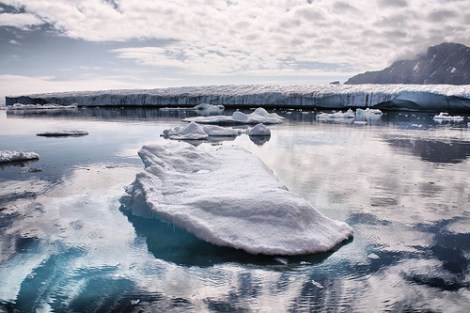
Ice in Greenland. See it while you can! (Photo by christine zenino.)
Everyone got pretty freaked out last month when we learned that 97 percent of Greenland’s ice sheet surface melted over the course of a week in July.
Well, almost everyone. Some people saw dollar signs. Literally, like in the cartoons.
We’ve said it before and we’ll say it again: There’s no stronger indictment of modern civilization than that one of the first topics of conversation after learning that climate change is melting ice is how quickly we can extract the climate-change-inducing resources that were trapped under all of that ice. If time travel existed, I suspect we’d see time travelers armed with future-laser-weapons ringing Greenland, politely suggesting that ravenous prospectors turn their ships around. (Not to mention a visitor or two to Titusville, Penn., circa 1859.)
But time travel doesn’t exist, so various corporate entities are sitting at a big wooden dining table around a big map of Greenland, napkins tucked into their starched collars, knives in each hand.
From the Guardian:
Oil and gas have been the focus of exploitation so far — but the EU sees just as much potential in a massive opening up of mining operations across the world’s biggest island, according to Antonio Tajani, the European commission’s vice-president and one of the most powerful politicians in the union. He called the move “raw material diplomacy”. …
Greenland — with strong historical ties to the EU through Denmark, though the island now has home rule — represents a vast and largely untapped resource. Drilling for oil in Greenland’s waters is now at the exploratory stage, having been impractical until recent advances in deep sea drilling. Mining has also been all but impossible across most of the country, which is covered in a 150m thick sheet of ice except for a few coastal strips, but melting ice and new techniques are likely to bring more of the region’s potential mineral resources within reach in the coming years.

Section of a map of resources in Greenland.
The Danes have a handy online map, showing each and every location ripe for resource extraction. Might as well plug that right into your vessel’s navigation system and get a head start. It’s like the Climate Exploitation Olympics sailing competition — and Europe’s primary worry is that it might fall behind.
China is already ahead; one of the most advanced metals mining projects in Greenland is nominally owned by London Mining, a UK company, but most of the finance and direction comes from China. Other countries are also eyeing the prize — although Greenland’s historical ties are mainly with Europe, it is geographically close to the US and Canada.
Once again, the Chinese ahead in the precious metal count.
Previous surveys have indicated that Greenland and its waters contain oil and frackable natural gas. One patch in Baffin Bay is believed to contain 4 billion barrels of oil.
So if you need me, I’ll be working on my flux capacitor.



